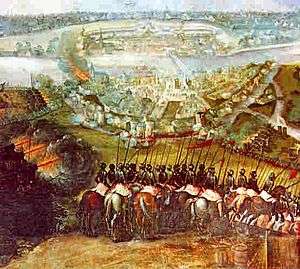Siege of Maastricht (1579)
| Siege of Maastricht | |||||||
|---|---|---|---|---|---|---|---|
| Part of the Eighty Years' War | |||||||
 Spanish troops storming the city of Maastricht. | |||||||
| |||||||
| Belligerents | |||||||
|
|
| ||||||
| Commanders and leaders | |||||||
|
Sebastien Tapin† |
| ||||||
| Strength | |||||||
| 1,200 soldiers and 6,000 militia | 18-20,000 soldiers | ||||||
| Casualties and losses | |||||||
| 900-1,000 soldiers, 800-4,000 civilians | 2,500 | ||||||
The Siege of Maastricht was a battle of the Eighty Years' War which lasted from March 12 - July 1, 1579. The Spanish were victorious.
Prelude
In 1579 the city of Maastricht was in the hands of the Dutch rebels. On March 12, 1579 the Spanish General Alexander Farnese started to lay siege to the city with his army consisting of 20,000 men. The Dutch garrison consisted of some 1,200 soldiers and some city militia.
Siege
The Spanish commander ordered his troops to sap the walls. The inhabitants of Maastricht too were digging to reach the Spanish tunnels. Deep under ground the fighting continued, hundreds of Spanish soldiers died as boiling water was poured into their tunnels. Others died because of a lack of oxygen when the Dutch defenders ignited fires within them. Another 500 Spanish soldiers died when a mine, which they planned to use to blow up the wall, exploded prematurely.
In the night of 29 June Farnese managed to get into the city while the exhausted defenders were asleep. Since the city had not surrendered after the walls had been breached, 16th-century law of war gave the victors the right to loot the conquered city. The Spanish looted the city for three days during which time many civilians lost their lives. The looting, although in later centuries greatly exaggerated, was particularly violent, perhaps because Farnese was in bed with fever during those three days.
_met_storm_verovert%2C_den_29_july_des_jaars_1579_(Jan_Luyken%2C_1679).jpg)
Coordinates: 50°51′N 5°41′E / 50.850°N 5.683°E
